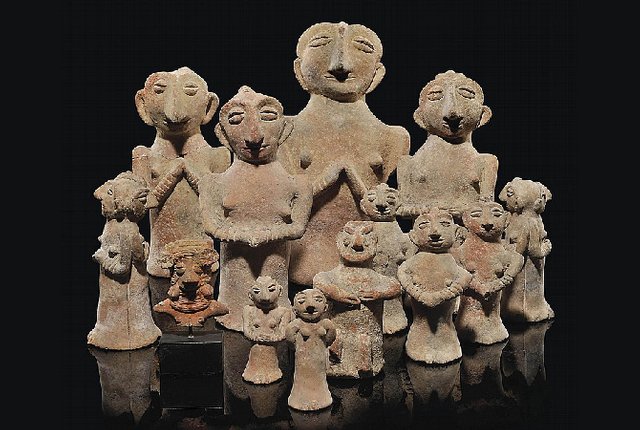Indian Art and Its Vibrant History
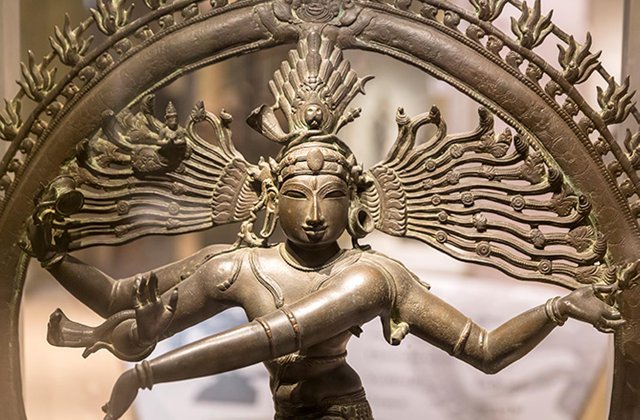
From early petroglyphs to a flourishing contemporary art scene, India’s vibrant artistic legacy is the result of a variety of cultural influences. The diversity of art from this area—which includes anything created in the historical regions of modern-day India, Bangladesh, and areas of Pakistan and Afghanistan—is reflected in vivid, distinct, and enchanting styles that represent many different civilizations.
Because some of the world’s major religions such as Buddhism, Hinduism, and Islam either began or flourished in India, much of Indian art is based in religious or political subject matter. Here, we uncover the history of Indian folk paintings, architecture, and sculpture, and explain how each evolved from the sociopolitical influences reflective of the period from which they originated.
A Brief History of Indian Art
A GROUP OF INDUS VALLEY TERRACOTTA FIGURES
Group of Indus Valley Terracotta Figures. Sold for £5,000 via Christie’s
Archaeologists discovered evidence of prehistoric rock art—carvings or drawings on cave rocks—in this area dating back at least 290,000 years. The oldest examples are the Bhimbetka petroglyphs found in central India. These consist of cupules, which are non-utilitarian hemispherical cup-shaped depressions that are hammered out of the rock surface. This type of rock art was the primary form of cave painting throughout the Paleolithic, Mesolithic and Neolithic periods, often depicting animal and human forms.
- The earliest known Indian art sculptures were produced by the Indus Valley Civilization between 2,500 B.C. and 1,800 B.C. They created small terracotta and bronze figures that also represented humans and animals such as cows and monkeys. In the 6th century B.C., the rise of Buddhism paved way for religious-themed art, often in the form of stone and bronze sculptures. During this time, religious artists also experimented with the creation of vast temples carved in stone and decorated with Greek-influenced columns.
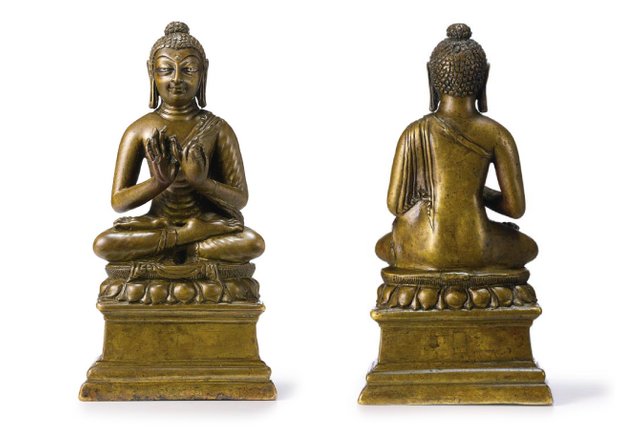
- SILVER-INLAID COPPER ALLOY FIGURE OF SHAKYAMUNI BUDDHA KASHMIR
Copper alloy figure of Shakyamuni Buddha Kashmir. Sold for HKD5,840,000 via Sotheby’s
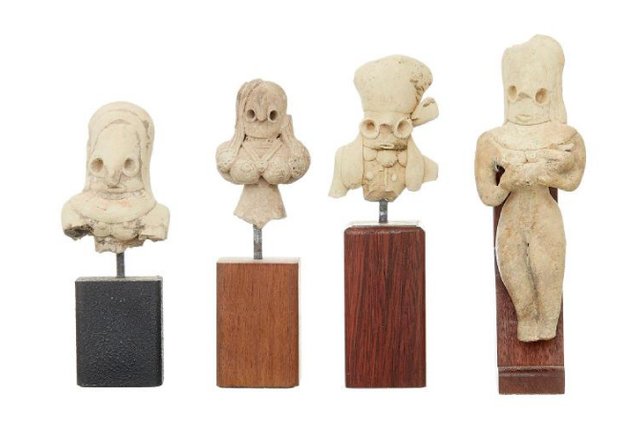
- Sculpture was a common practice among Indian Buddhists and Hindus. Hinduism continued to be a main focus of Indian art for centuries, as sculptures of deities like Shiva were commonly produced. By the 16th century, Islam gained importance under the Mughal Empire and art production grew under Islamic rulers. During this time, the arts prospered and in 1631 construction began on the Taj Mahal.
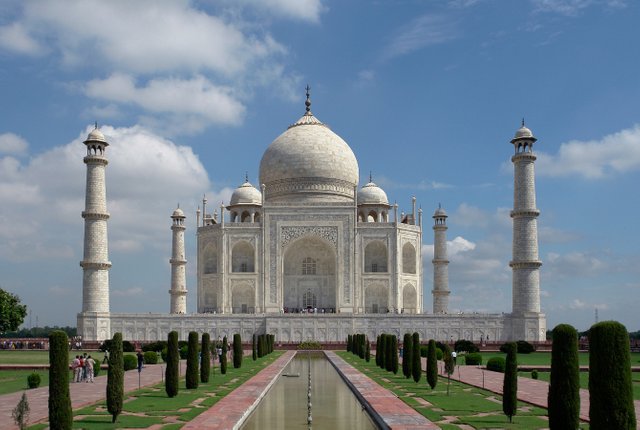
British involvement in India began in the 18th century, during which time they established art schools to promote European styles. As a result, local art styles merged with foreign influences and traditional art forms were often romanticized or exaggerated to appeal to European buyers. In 1947, India gained independence from the British empire which pushed local artists to search for a new style. Contemporary Indian art incorporates traditional elements and influences from the rich history of the country.
Types of Indian Art
four indus valley pottery sculptures
Indus Valley pottery sculptures. Sold for AUD800 via Leonard Joel
Each region of India offered its own distinct style of art. Religious motifs are some of the most common subject matter, often featuring mythological human and animal forms as well as elaborate ornamentation. The three most prevalent art forms to span India’s history are painting, architecture, and sculpture.
Paintings
Each style of painting that emerged in India represented traditions, customs, and ideologies passed down from previous generations. Though early paintings existed on walls or as murals, the art form was eventually transferred to more modern materials such as paper, canvas, cloth, and other mediums. Below are some of the most popular Indian folk art painting styles.
Madhubani Paintings
Some of the most popular paintings from India are Madhubani paintings. This style originated in the Mithila region of Bihar as a form of wall art, but wasn’t widely known to the Western world until British civil servant and art historian W.G. Archer stumbled upon their brilliance in 1934 while inspecting damage from an earthquake near the border of India and Nepal.
The Madhubani style is represented by a simple and evocative portrayal of culture and tradition, typically depicting mythological scenes. Artists juxtapose vibrant imagery with pared-down patterns, often bearing floral, animal, or bird motifs. The art form is practiced in many different styles including Bharni, Katchni, Geru, Godna, and Tantric.
two Madhubani paintings
Madhubani paintings. Sold for £250 via Roseberys
Miniature Paintings
These small works created mostly as illustrations for manuscripts were initially found on palm leaves, painted for merchants who carried them throughout their travels across the subcontinent in the 10th and 12th centuries. The art form became increasingly important throughout the Mughal and Rajput courts. Miniature paintings were highly detailed and intricate, drawing from Persian techniques. Themes ranged from religious and historical scenes to depictions of everyday life.
Pattachitra Paintings
Another early form of painting, this style dates back to the 12th century B.C. near Orissa, an eastern Indian state on the Bay of Bengal. The small villages within the area still produce this style of painting today. Pattachitra literally translates to “cloth picture,” aptly describing this traditional, cloth-based type of scroll painting. Known for its intricate details and mythological narratives, the paintings call upon angular, bold lines and draw extensively from Mughal-era influences.
Warli Paintings
Warli folk paintings, a form of indigenous Indian art, date back 2,500 years. The style originated in Maharashtra, a state spanning the western part of Central India, where it is still widely practiced today. Typically created on the walls of huts, Warli paintings utilize linear and monochromatic hues and an elementary style of execution that resembles cave painting. Contrary to other types of tribal art, which feature an abundance of colors, this style utilizes earth-tones and neutral shades to depict daily activities of local people such as farming, dancing, and hunting.
red warli painting on paper
Warli painting. Image via Wikimedia Commons.
Though Madhubani, Pattachitra, Warli, and miniature painting are some of the most prominent styles, there are several other types of Indian folk paintings that derive from different periods and regions within the subcontinent, which include:
Thanjavur paintings: This South Indian painting style flourished between the 16th and 18th centuries. Thanjavur paintings are colorful panel paintings done on a wood plank, usually depicting a deity as the primary subject matter of the composition.
Kalamkari: This type of hand-painted or block-printed cotton textile is produced in the Indian states of Andhra Pradesh and Telangana. It was traditionally used for making narrative scrolls and panels and has a strong connection to Persian motifs.
Gond paintings: Developed by the Gondi tribe of Central India, this type of art celebrates the natural world, depicting anything from lush greenery to animals. The paintings are created using a series of intricately arranged dots and dashes.
Phad paintings: Phad paintings date back thousands of years as a religious form of scroll painting that depicts battlefields, adventure stories, and folk deities.
Notable Indian Paintings
Raja Ravi Varma, “Shakuntala,” 1870
This epic painting depicts Shakuntala, an important character of Mahabarata, one of the two major Sanskrit epic poems of ancient India.
Abindranath Tagore, “Bharat Mata,” 1905
Founder of the Bengal School of Art, Tagore’s painting is of great and historical value as it depicts a woman, dressed like a sadhvi (virtuous woman) in a sacred, saffron sari, holding a book, sheaves of paddy, white cloth, and garland in her four hands.
Amrita Sher-Gil, “Self Portrait,” 1931
Amrita Sher-Gil was one of India’s most important modern artists. This was the first painting by the artist to be offered by Christie’s, and one of only eight works by the artist to be auctioned globally.
Architecture
taj mahal in India
Taj Mahal, Agra, India. Image via Wikimedia Commons.
Much like paintings, Indian architecture took on various styles and forms over the years. Many of these structures have become globally renowned, such as the Taj Mahal and South Indian Temples. Architectural styles have changed over time and modern structures reflect influences from a variety of countries as a result of India’s global discourse.
Cave architecture was one of the earliest forms, created by Hindus, Jains, and Buddhists who produced whole temples from rock. One of the most famous rock-cut temples is the Kailasa Temple, located in the Ellora Caves in Maharashtra, India and known for its size and sculptural treatment. Beginning around the 5th century B.C., large, free-standing temples emerged. Indian architecture often included religious elements such as an altar and shelter for worshipers seeking enlightenment.
Throughout the 12th century, architecture produced for Islamic patrons emerged after Muhammad of Ghor made Delhi a Muslim capital in 1193. The Delhi Sultanate—which formed in 1206 and reigned over large parts of the Indian subcontinent for 320 years—came from Central Asia via Afghanistan and preferred a style of architecture largely derived from Iranian influences.
Muslim leaders hired local craftsmen to build large structures, much different than those previously built in India. This included mosques, which featured open courtyards surrounded by covered hallways that were oriented towards sacred cities. A variety of Indo-Islamic architectural styles emerged, which fused local and Islamic traditions and influenced modern Indian, Paikstani, and Bangladeshi architecture.
Modern Indian architecture still honors and upholds tradition while meeting the needs of a growing population. Modern structures didn’t appear until India gained independence from the British in 1947. At that time, the Indian Punjab government commissioned famous Swiss-French architect and designer Le Corbusier to lead urban planning of the city of Chandigarh. With the project emerged a renewed interest in and rebirth of Indian architecture.
Notable Indian Architecture
The Iron Pillar, Delhi
This pillar, built in the 4th century, features Sanskrit inscription in Brahmi script that states it was created in honor of the Hindu god Vishnu. The pillar showcases India’s prowess in metallurgy, a branch of science that focuses particularly on the properties, production, and purification of metals.
Konark Sun Temple, Konark, India
Built in the 13th century, this impressive temple is dedicated to the Hindu sun god Surya. It was carved from stone in the form of a 100-foot-high chariot with immense wheels and horses.
Taj Mahal, Agra, Uttar Pradesh
One of the seven wonders of the world, this mausoleum was built in the 17th century under Mughal emperor Shah Jahan. The architectural marvel bears a combination of Hindu and Indo-Islamic techniques.
Sculpture
A gilt copper alloy figure of Avalokiteshvara Indian, Himalayan & Southeast Asian Art
Gilt copper alloy figure. Sold for $377,000 via Bonhams (March 2015).
Sculpture continues to be a favored medium for artistic expression in India, primarily as a form of religious art. Buildings were profusely adorned, and subject matter largely consisted of abstracted human forms used to illustrate the principles of Hinduism, Buddhism, and Jainism. Female deities such as Shakti, Kali, and Brahma were often depicted in Indian sculpture.
Indian sculpture extends from the Indus Valley, where terracotta figurines were some of the first sculptures to be produced. Throughout the Mauryan Dynasty, which spanned from the 4th to 2nd centuries B.C., large stone pillars appeared at crossroads and important sites. They often had lotus-shaped tops and figures of lions which were symbols of imperial rule. Many large stone images of gods were produced during this period, followed by smaller versions that were placed on Buddhist monuments. Stupas, burial mounds, were surrounded by ornately carved gateways featuring an array of religious symbols. More mature Indian figurative sculpture began appearing in the 2nd and 1st centuries B.C.
Over the succeeding centuries, a wide range of styles and traditions subsequently flourished throughout different areas. One of the most prominent structures is the Elephanta Caves, a collection of cave temples predominately dedicated to the Hindu god Shiva, constructed from the mid-5th to 6th centuries A.D. By the 9th and 10th centuries, Indian sculpture had reached a form that changed relatively little compared to what it is today and was used primarily as part of architectural decoration.
indian sculpture
Ramkinkar Baij, The Perambulator. Sold for INR4,200,000 via Pundole’s (April 2015).
In the early 20th century, Indian sculpture adapted to western academic art traditions, and styles were greatly influenced by realist artists who worked on secular subjects at British art schools. There was a significant departure from ancient and traditional forms depicting myths and deities. In the 1940s and 1950s, painter and sculptor Ramkinkar Baij worked to fuse both Western art and traditional Indian forms, experimenting with unconventional materials such as concrete, gravel, and cement. This experimentation lives on in contemporary Indian sculpture, which equally borrows from traditional techniques and subject matter while exploring new approaches.
Notable Indian Sculptures
Dancing Girl of Mohenjo-Daro
This bronze statue is believed to be nearly 4,500 years old. Made of delicate metal, it depicts a young girl with a plethora of bangles on her arms, similar to that of women from Banjara, a community with origins in Rajasthan.
The Ashoka Pillars
Constructed by Mauryan emperor Ashoka in the 3rd century, this series of columns is scattered throughout India. The most famous pillar, the Lion Capital of Sarnath, features four lions on their hind legs with their backs touching. It was adopted as India’s National Emblem in 1950.
Ajanta Caves
Situated in the Maharashtra region, this group of rock-cut Buddhist caves includes a variety of cave paintings and sculptures. Constructed in the 2nd century, they are largely considered to be India’s best surviving specimens of art and architecture.
From prehistoric rock carvings to contemporary interpretations of traditional styles, Indian and South Asian art continues to demonstrate the breadth of artistic and cultural influence that has informed and shaped its aesthetic over the course of Indian art history. While traditional works of art showcase religious motifs and mythological depictions, contemporary works match the cultural and ideological diversity of the nation.
